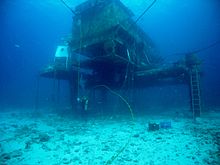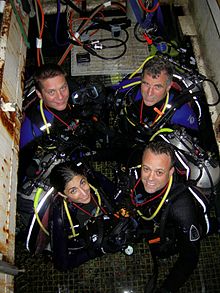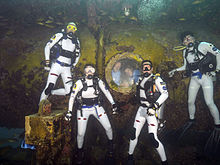NEEMO
| NEEMO Program | |
|---|---|
 | |
 A NEEMO 11 crewmember works outside the undersea habitat "Aquarius" | |
| Mission statement | "To see what extreme environmental challenges astronauts may face in space, and to form solutions by using the ocean, as an equivalent environment on earth" |
| Location | Florida, United States |
| Owner | NASA, Florida International University, Aquarius Reef Base |
| Established | 2001 |
| Website | www |
NASA Extreme Environment Mission Operations, or NEEMO,[1] is a NASA analog mission that sends groups of astronauts, engineers and scientists to live in the Aquarius underwater laboratory, the world's only undersea research station, for up to three weeks at a time in preparation for future space exploration.[2]
Aquarius is an underwater habitat 3.5 miles (5.6 km) off Key Largo, Florida, in the Florida Keys National Marine Sanctuary. It is deployed on the ocean floor next to deep coral reefs 62 feet (19 m) below the surface.
NASA has used it since 2001 for a series of space exploration simulation missions, usually lasting 7 to 14 days, with space research mainly conducted by international astronauts. The mission had cost about 500 million U.S. dollars. The crew members are called aquanauts (as they live underwater at depth pressure for a period equal to or greater than 24 continuous hours without returning to the surface), and they perform EVAs in the underwater environment.[2] A technique known as saturation diving allows the aquanauts to live and work underwater for days or weeks at a time. After twenty four hours underwater at any depth, the human body becomes saturated with dissolved gas. With saturation diving, divers can accurately predict exactly how much time they need to decompress before returning to the surface. This information limits the risk of decompression sickness. By living in the Aquarius habitat and working at the same depth on the ocean floor, NEEMO crews are able to remain underwater for the duration of their mission.
For NASA, the Aquarius habitat and its surroundings provide a convincing analog for space exploration.[2] Much like space, the undersea world is a hostile, alien place for humans to live. NEEMO crew members experience some of the same challenges there that they would on a distant asteroid, planet (i.e. Mars) or Moon. During NEEMO missions, the aquanauts are able to simulate living on a spacecraft and test spacewalk techniques for future space missions. Working in space and underwater environments requires extensive planning and sophisticated equipment. The underwater condition has the additional benefit of allowing NASA to "weight" the aquanauts to simulate different gravity environments.[3]
Until 2012, Aquarius was owned by the National Oceanic and Atmospheric Administration (NOAA) and operated by the National Undersea Research Center (NURC) at the University of North Carolina–Wilmington as a marine biology study base.
Since 2013, Aquarius is owned by Florida International University (FIU).[4] As part of the FIU Marine Education and Research Initiative, the Medina Aquarius Program is dedicated to the study and preservation of marine ecosystems worldwide and is enhancing the scope and impact of FIU on research, educational outreach, technology development, and professional training. At the heart of the program is the Aquarius Reef Base.[5]
Missions
NEEMO 1: October 21–27, 2001


NASA Aquanaut Crew:
NURC Support Crew:
NEEMO 2: May 13–20, 2002
NASA Aquanaut Crew:
NURC Support Crew:
- Thor Dunmire
- Ryan Snow
NEEMO 3: July 15–21, 2002
NASA Aquanaut Crew:
NURC Support Crew:
- Byron Croker
- Michael Smith
NEEMO 4: September 23–27, 2002
NASA Aquanaut Crew:
NURC Support Crew:

NEEMO 5: June 16–29, 2003
NASA Aquanaut Crew:
NURC Support Crew:
NEEMO 6: July 12–21, 2004
NASA Aquanaut Crew:
NURC Support Crew:
- Craig B. Cooper
- Joseph March
- Marc Reagan, Mission Director
NEEMO 7: October 11–21, 2004
NASA Aquanaut Crew:
NURC Support Crew:
- James Talacek
- Billy Cooksey
- Bill Todd, Mission Director
NEEMO 8: April 20–22, 2005
NASA Aquanaut Crew:
- Michael L. Gernhardt, Commander[20][21]
- John D. Olivas
- Scott Kelly
- Monika Schultz
NURC Support Crew:
- Craig B. Cooper
- Joseph March
- Bill Todd, Mission Director
NEEMO 9: April 3–20, 2006

NASA Aquanaut Crew:
- Dafydd Williams, Commander[22][23]
- Nicole P. Stott
- Ronald J. Garan Jr.
- Timothy J. Broderick, M.D.
NURC Support Crew:
- James F. Buckley
- Ross Hein
- Marc Reagan, Mission Director
NEEMO 10: July 22–28, 2006
NASA Aquanaut Crew:
NURC Support Crew:
- Mark Hulsbeck
- Dominic Landucci
- Marc Reagan, Mission Director
NEEMO 11: September 16–22, 2006
NASA Aquanaut Crew:
NURC Support Crew:
- Larry Ward
- Roger Garcia
- Marc Reagan, Mission Director
NEEMO 12: May 7–18, 2007

NASA Aquanaut Crew:
- Heidemarie Stefanyshyn-Piper, Commander[28][29]
- José M. Hernández
- Josef Schmid, M.D.
- Timothy J. Broderick, M.D.
NURC Support Crew:
- Dominic Landucci
- James Talacek
- Marc Reagan, Mission Director
NEEMO 13: August 6–15, 2007
NASA Aquanaut Crew:
NURC Support Crew:
- James F. Buckley
- Dewey Smith
- Marc Reagan, Mission Director
NEEMO 14: May 10–23, 2010
NASA Aquanaut Crew:
Aquarius Reef Base support crew:
- James Talacek
- Nate Bender
- Bill Todd, Mission Director
NEEMO 15: October 20–26, 2011
NASA Aquanaut Crew:
Aquarius Reef Base support crew:
- James Talacek
- Nate Bender
DeepWorker 2000 submersible crew:
NEEMO 16: June 11–22, 2012

NASA Aquanaut Crew:
Aquarius Reef Base support crew:
DeepWorker 2000 submersible crew:
- Stanley G. Love[40][41][42][43]
- Steve Giddings
- Serena M. Auñón
- Bill Todd
- Michael L. Gernhardt
- Andrew Abercromby
- Steve Chappell
SEATEST II: September 9–13, 2013
Space Environment Analog for Testing EVA Systems and Training[44] ( NEEMO 17 ) Designation skipped[45]
NASA Aquanaut Crew:
- Joseph M. Acaba, Commander
- Kate Rubins
- Andreas Mogensen
- Soichi Noguchi
Aquarius Reef Base support crew:[46]
NEEMO 18: July 21–29, 2014
NASA Aquanaut Crew:
Professional habitat technicians, Aquarius Reef Base support crew:
- James Talacek
- Hank Stark (FIU)
NEEMO 19: September 7–13, 2014

NASA Aquanaut Crew:
- Randolph Bresnik, Commander[45]
- Andreas Mogensen, Flight Engineer 1
- Jeremy Hansen, Flight Engineer 2
- Hervé Stevenin,[47] Flight Engineer 3
Aquarius Reef Base support crew:
NEEMO 20: July 20 – August 2, 2015
NASA Aquanaut Crew:[48]

- Luca Parmitano, ESA, commander
- Serena M. Auñón, NASA
- David Coan, NASA EVA Management Office engineer[49]
- Norishige Kanai, JAXA
Professional habitat technicians, Aquarius Reef Base support crew:
- Mark Hulsbeck (FIU)
- Sean Moore (FIU)
NEEMO 20 mission objective was to simulate the time delays associated with sending and receiving commands between controllers on Earth and astronauts on Mars. Additional EVAs will simulate working on the surface of an asteroid, and the use of the DeepWorker submersible as an underwater stand-in for the Multi-Mission Space Exploration Vehicle.[50]
NEEMO 21: July 21 – August 5, 2016
The NEEMO 21 mission was scheduled to begin July 18, 2016 and conclude August 3, 2016; however, the mission start was shifted to July 21, 2016 as a result of unfavorable weather conditions.
NASA Aquanaut Crew:[51]
- Reid Wiseman, NASA, Commander 1
- Megan McArthur, NASA, Commander 2
- Marc O´Gríofa
- Matthias Maurer, ESA
- Noel Du Toit
- Dawn Kernagis
Professional habitat technicians, Aquarius Reef Base support crew:
- Hank Stark (FIU)
- Sean Moore (FIU)
NEEMO 22: June 18–27, 2017
NASA Aquanaut Crew:
- Kjell Lindgren, NASA, Commander
- Pedro Duque, ESA
- Trevor Graff, NASA/Jacobs
- Dominic D'Agostino, USF
Professional habitat technicians, Aquarius Reef Base support crew:
- Mark Hulsbeck (FIU)
- Sean Moore (FIU)
NEEMO 23: June 10–22, 2019
NASA all-female Aquanaut Crew:[52]
- Samantha Cristoforetti, ESA, Commander
- Jessica Watkins, NASA astronaut candidate
- Csilla Ari D’Agostino, a neurobiologist at the University of South Florida
- Shirley Pomponi, Marine biologist at Harbor Branch Oceanographic Institute of Florida Atlantic University
Professional habitat technicians, Aquarius Reef Base support crew:
- Mark Hulsbeck (FIU)
- Tom Horn (FIU)
See also
- Continental Shelf Station Two – Undersea research habitat in the Red Sea
- SEALAB – Experimental underwater habitats developed by the United States Navy
References
- ^ Loff, Sarah (Jun 24, 2015). "NEEMO - NASA Extreme Environment MIssion Operations". NASA.
- ^ a b c NASA (March 21, 2006). "NEEMO History". National Aeronautics and Space Administration. Retrieved November 21, 2011.
- ^ Loff, Sarah (Jun 24, 2015). "About NEEMO (NASA Extreme Environment Mission Operations)". NASA.
- ^ Communications, Florida International University-Digital. "Medina Aquarius Program". environment.fiu.edu.
- ^ Communications, Florida International University-Digital. "About". environment.fiu.edu.
- ^ a b c d e NASA (February 27, 2006). "Behind the Scenes: Training - NEEMO History". NASA. Archived from the original on July 15, 2003. Retrieved March 23, 2012.
- ^ NASA (June 2011). "Astronaut Bio: Edward Michael "Mike" Fincke (06/2011)". NASA. Retrieved September 22, 2011.
- ^ NASA (April 21, 2011). "Life Sciences Data Archive : Experiment". NASA. Archived from the original on October 24, 2011. Retrieved November 9, 2011.
- ^ Walheim, Rex (September 24, 2002). "NEEMO 4 Journals". NASA. Archived from the original on July 24, 2003. Retrieved March 10, 2012.
- ^ NOAA (May 17, 2010). "NEEMO 4 Journals". NOAA. Archived from the original on March 20, 2012. Retrieved March 10, 2012.
- ^ NASA (April 21, 2011). "Life Sciences Data Archive : Experiment". NASA. Archived from the original on March 22, 2012. Retrieved March 10, 2012.
- ^ NASA (2003). "NEEMO 5". NASA. Archived from the original on November 18, 2004. Retrieved March 10, 2012.
- ^ "Aquarius - First Space Station Science Officer Leads Crew of Four NASA Aquanauts On 14-Day NOAA Aquarius Undersea Mission". University of North Carolina Wilmington. May 17, 2010. Archived from the original on December 12, 2012. Retrieved March 10, 2012.
- ^ Whitson, Peggy (June 19, 2003). "NEEMO 5 Journals". NASA. Archived from the original on July 15, 2003. Retrieved March 10, 2012.
- ^ NASA (August 3, 2004). "NEEMO 6". NASA. Archived from the original on November 18, 2004. Retrieved February 26, 2012.
- ^ NASA (September 6, 2011). "Life Sciences Data Archive : Experiment". NASA. Archived from the original on April 5, 2012. Retrieved February 26, 2012.
- ^ NASA (October 13, 2004). "NEEMO 7". NASA. Archived from the original on October 30, 2004. Retrieved March 10, 2012.
- ^ Canadian Space Agency (August 9, 2004). "CSA - Neemo 7 Mission". Canadian Space Agency. Archived from the original on March 9, 2012. Retrieved March 10, 2012.
- ^ NASA (April 21, 2011). "Life Sciences Data Archive : Experiment". NASA. Archived from the original on April 5, 2012. Retrieved March 10, 2012.
- ^ NOAA (May 18, 2010). "NEEMO 8". University of North Carolina Wilmington. Archived from the original on March 20, 2012. Retrieved February 25, 2012.
- ^ NASA (April 21, 2011). "Life Sciences Data Archive : Experiment". NASA. Archived from the original on March 22, 2012. Retrieved February 25, 2012.
- ^ NASA (2006). "NASA's Undersea Crew is Heads Above Water". NASA. Retrieved September 23, 2011.
- ^ NASA (April 3, 2006). "NASA's NEEMO 9 Aquanaut Human Performance Study Begins". NASA. Retrieved November 8, 2011.
- ^ NASA (2006). "NASA Uses Undersea Lab to Prep for Future Space Exploration". NASA. Retrieved March 21, 2012.
- ^ NASA (July 22, 2006). "NASA - NEEMO 10 Mission Journal". NASA. Retrieved March 21, 2012.
- ^ NASA (May 11, 2010). "NEEMO 11". NASA. Retrieved September 26, 2011.
- ^ NASA (September 1, 2006). "NASA Continues Space Exploration Research With Undersea Lab". NASA. Retrieved November 8, 2011.
- ^ NASA (May 17, 2007). "NEEMO 12". NASA. Retrieved March 10, 2012.
- ^ NEEMO 12 Topside Team (May 6, 2007). "NASA - NEEMO 12 Topside Journal". NASA. Retrieved March 10, 2012.
{{cite web}}: CS1 maint: numeric names: authors list (link) - ^ NASA (July 24, 2007). "NASA Announces Next Undersea Exploration Mission Dates and Crew". NASA. Retrieved February 3, 2012.
- ^ Topside Team (August 8, 2007). "NEEMO 13 Topside Report - Training Week". NURC. Archived from the original on May 9, 2012. Retrieved February 3, 2012.
- ^ NASA (July 9, 2010). "NASA - NEEMO 14". NASA. Retrieved March 18, 2012.
- ^ Alexander, Aaron (2010). "Archive for the 'NEEMO 14' Mission". NURC. Archived from the original on March 28, 2012. Retrieved March 18, 2012.
- ^ NASA (May 7, 2010). "NASA - NEEMO 14 Topside Report No. 1, May 7, 2010". NASA. Retrieved March 18, 2012.
- ^ a b NASA (September 19, 2011). "NASA - NASA Announces 15th Undersea Exploration Mission Date And Crew". NASA. Retrieved July 11, 2012.
- ^ NASA (October 27, 2011). "NASA - NEEMO 15 Topside Reports". NASA. Retrieved March 18, 2012.
- ^ NASA (April 16, 2012). "NASA - NASA Announces 16th Undersea Exploration Mission Dates and Crews". NASA. Retrieved April 17, 2012.
- ^ Peake, Tim (April 29, 2012). "NEEMO 16 - In search of an asteroid". European Space Agency. Retrieved May 3, 2012.
- ^ The NEEMO Mission Management and Topside Support Team (June 12, 2012). "NEEMO 16 Mission Day 2 - Status Report" (PDF). NASA. Retrieved July 16, 2012.
- ^ Love, Stan (June 17, 2012). "Dr. Love's Underwater Blog: NEEMO 16". NASA. Archived from the original on December 12, 2012. Retrieved July 11, 2012.
- ^ Squyres, Steve (June 17, 2012). "NEEMO 16: EVA Divers and Subs". NASA. Archived from the original on December 13, 2012. Retrieved July 11, 2012.
- ^ Love, Stan (June 18, 2012). "Dr. Love's Underwater Blog: Mobility and Stability with DeepWorkers". NASA. Archived from the original on June 21, 2012. Retrieved July 11, 2012.
- ^ Stevenin, Hervé (June 19, 2012). "The NEEMO 16 Aquanauts meet the Men in Black". Yahoo! Inc. Retrieved July 13, 2012.
- ^ Garcia, Mark (Apr 13, 2015). "NASA, International Partners Plan Undersea Training Mission". NASA.
- ^ a b Bergin, Chris (June 11, 2014). "NEEMO returns with two new underwater missions". NASASpaceflight. Retrieved June 24, 2014.
- ^ Computing, HySpeed (Sep 16, 2013). "Aquarius SEATEST II – Astronauts emerge from a successful underwater mission".
- ^ "Hervé Stevenin". www.esa.int.
- ^ "NEEMO 20 Crew (L to R) CDR Luca Parmitano (ESA), Serena Aunon (NASA), David Coan (NASA), Norishige Kanai, (JAXA), inside Aquarius Mark Hulsbeck (FIU) and Sean Moore (FIU)". Jul 20, 2015 – via Flickr.
- ^ "NASA Prepares for Future Space Exploration with International Undersea Crew". June 24, 2015.
- ^ "NEEMO 20 to build knowledge base on delayed deep space communications, Chris Bergin, nasaspaceflight". July 6, 2015.
- ^ Loff, Sarah (2016-07-22). "Aquanauts Splash Down, Beginning NEEMO 21 Research Mission". Retrieved 2016-07-24.
- ^ Emily Toomey (July 29, 2019). "NASA Scientists and Astronauts Practice for Space Missions on the Seafloor". Smithsonian magazine.
External links
![]() Media related to NEEMO at Wikimedia Commons
Media related to NEEMO at Wikimedia Commons

